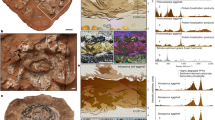Abstract
IT has long been recognized that the magnesian calcite skeleton of echinoderms is laid down as a crystal network by a syncytial protoplasmic mass that permeates the cavities within it. It is usually stated that all components except echinoid teeth1, be they spines, thecal plates, pedicellaria valves, or any other skeletal feature, behave crystallographically as a single crystal of calcite2–4. In other metazoan tissues that have been investigated the arrangement of the skeleton is that of a two phase system, with a softer and a harder phase intimately mingled. This is true, for example, of bone5, dentine, enamel6, arthropod cuticle7,8, brachiopod shell9,10, mollusc skeleton11 and coral12. Two phase construction is also seen in wood13. This double component nature of hard skeletal elements appears to impart considerable mechanical strength14. The almost universal occurrence of two phase construction in skeletal materials elsewhere and the considerable advantages such a structure clearly bestows make its lack in echinoderms surprising.
This is a preview of subscription content, access via your institution
Access options
Subscribe to this journal
Receive 51 print issues and online access
$199.00 per year
only $3.90 per issue
Buy this article
- Purchase on Springer Link
- Instant access to full article PDF
Prices may be subject to local taxes which are calculated during checkout
Similar content being viewed by others
References
Salter, S. J. A., Phil. Trans. Roy. Soc., 151, 387 (1861).
Schmidt, W. J., Zool. Jb. Anat., 47, 113 (1925).
West, C. D., J. Paleont., 11, 458 (1937).
Raup, D., J. Paleont., 39, 934 (1965).
McLean, F. C., and Urist, M. R., Bone (University of Chicago Press, 1961).
Frank, R. M., Sognnaes, R. F., and Kern, R., Amer. Assoc. Adv. Sci. Pub., 64, 163 (1960).
Jensen, M., and Weis-Fogh, T., Phil. Trans. Roy. Soc., B, 245, 137 (1962).
Rudall, K. M., in Aspects of Insect Biochemistry (edit. by Goodwin, T. W.), Biochem. Soc. Symp., 25, 83 (1966).
Williams, A., Biol. Rev., 31, 243 (1956).
Williams, A., Nature, 211, 1146 (1966).
Wilbur, K. M., Amer. Assoc. Adv. Sci. Pub., 64, 15 (1960).
Wainwright, S. A., Quart. J. Microsc. Sci., 104, 169 (1963).
Cottrell, A. H., The Mechanical Properties of Matter (Wiley, London, 1964).
Currey, J. D., Biorheology, 2, 1 (1964).
Okazaki, K., Embryologia, 5, 283 (1960).
Garrido, J., and Blanco, J., C.R. Acad. Sci., Paris, 224, 485 (1947).
Nissen, H.-U., Neues Jb. Miner. Geol. Palaont. Abh., 117, 230 (1963).
Vose, G. P., Anat. Rec., 145, 183 (1963).
Scott, D. B., Ussing, M. J., Sognnaes, R. F., and Wyckoff, R. W. G., J. Dent. Res., 31, 74 (1952).
Gregoire, C., J. Biophys. Biochem. Cytol., 3, 797 (1957).
Currey, J. D., Quart. J. Microsc. Sci., 103, 111 (1962).
Author information
Authors and Affiliations
Rights and permissions
About this article
Cite this article
CURREY, J., NICHOLS, D. Absence of Organic Phase in Echinoderm Calcite. Nature 214, 81–83 (1967). https://doi.org/10.1038/214081a0
Issue Date:
DOI: https://doi.org/10.1038/214081a0
This article is cited by
-
Polykristalliner Calcit bei Seeigeln (Echinodermata, Echinoidea)
Zeitschrift f�r Zellforschung und Mikroskopische Anatomie (1971)
-
Calcification in sea urchins
Calcified Tissue Research (1969)
-
Morphologic der seeigelz�hne II. Die gekielten Z�hne der echinacea (Echinodermata, echinoidea)
Zeitschrift f�r Morphologie der Tiere (1969)
-
Pentamerism and the Calcite Skeleton in Echinoderms
Nature (1967)
Comments
By submitting a comment you agree to abide by our Terms and Community Guidelines. If you find something abusive or that does not comply with our terms or guidelines please flag it as inappropriate.



